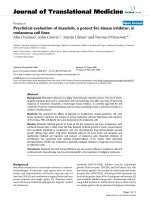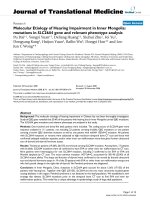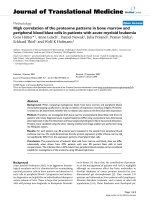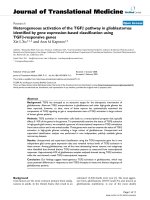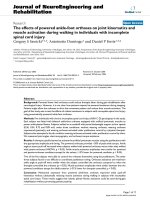báo cáo hóa học:" In spite of good intentions: patients'''' perspectives on problematic social support interactions" pdf
Bạn đang xem bản rút gọn của tài liệu. Xem và tải ngay bản đầy đủ của tài liệu tại đây (251.99 KB, 7 trang )
BioMed Central
Page 1 of 7
(page number not for citation purposes)
Health and Quality of Life Outcomes
Open Access
Research
In spite of good intentions: patients' perspectives on problematic
social support interactions
Carla Boutin-Foster*
Address: Division of General Internal Medicine, Weill Medical College of Cornell University, 525 E. 68 th Street, Box 46- Baker Tower 14, New
York, New York 10021, USA
Email: Carla Boutin-Foster* -
* Corresponding author
Qualitative studySocial supportSocial networksCoronary artery disease
Abstract
Background: In the setting of an acute coronary syndrome, the natural inclination of friends and
family members is to provide social support. However, their efforts may be perceived as being
problematic or unhelpful. The objective of this study was to identify the characteristics of
problematic social support interactions from the perspectives of patients.
Methods: This was a qualitative study among a purposive sample of 59 patients who had been
hospitalized for an acute coronary syndrome. Patients were asked: "Can you describe the types of
things that your family members, close friends, and health care providers did during this period to
try to be helpful or supportive but you felt was unhelpful or felt that it caused you more stress."
Responses were analyzed using qualitative techniques and reviewed by two independent
corroborators.
Results: The types of behaviors performed by social network members that were perceived as
being unhelpful were grouped under 5 themes: (1) excessive telephone contact, (2) high expression
of emotions, (3) unsolicited advice, (4) information without means for implementation, and (5)
taking over.
Conclusion: Patients in this study described actions of their social network members that were
intended to be supportive but instead were perceived as problematic because they were in excess
of what was needed, they were incongruous with what was desired, or they contributed to negative
feelings. Helping social networks to understand the potential problematic aspects of social support
can aid in tailoring effective social support interventions.
Background
Acute coronary syndromes such as unstable angina or
myocardial infarction account for approximately 2.5 mil-
lion hospitalizations in the United States annually [1,2].
The period surrounding an acute coronary syndrome is
often marked by fear, anxiety, and uncertainty about the
resumption of activities such as work or sexual activity [3-
5]. Under these circumstances, social support is often
mobilized as a resource to help patients cope with their
illness. Social support is a set of interactive and dynamic
Published: 05 September 2005
Health and Quality of Life Outcomes 2005, 3:52 doi:10.1186/1477-7525-3-52
Received: 12 April 2005
Accepted: 05 September 2005
This article is available from: />© 2005 Boutin-Foster; licensee BioMed Central Ltd.
This is an Open Access article distributed under the terms of the Creative Commons Attribution License ( />),
which permits unrestricted use, distribution, and reproduction in any medium, provided the original work is properly cited.
Health and Quality of Life Outcomes 2005, 3:52 />Page 2 of 7
(page number not for citation purposes)
processes in which particular actions or behaviors are
directed at an individual to positively effect his or her
social, psychological, or physical well-being [6]. Social
support can be provided in the form of emotional support
such as providing love and affection, tangible support that
is provided by giving practical assistance with a task, and
informational support that is provided by giving guidance
or advice [7].
There has been a lot of enthusiasm and interest in the ben-
efits of social support in coronary artery disease. However,
this enthusiasm has been tempered by studies demon-
strating that too much social support can be problematic.
Revenson uses the metaphor of a "double-edged sword"
in describing social support interactions [8]. She describes
positive and problematic support from social networks as
two different domains that can coexist; efforts to provide
social support can alleviate stress and can also augment
stress.
Much of the work on the problematic aspects of social
support interactions has been in the setting of chronic
conditions such as arthritis, HIV, and cancer. In a study
among patients with rheumatoid arthritis, problematic
social support interactions was associated with greater
fatigue [9]. Among patients with HIV, unsupportive social
interactions correlated with greater depression [10].
Among breast cancer patients, having unsupportive social
network interactions was associated with lower emotional
well-being and worse social functioning [11]. Many stud-
ies have documented the positive aspects of social support
among coronary artery disease patients. However, less is
known about problematic social support interactions in
this setting.
The experience of having an acute coronary syndrome
provides a useful context for understanding problematic
social support interactions. Because this is a period
marked by high emotions and stress, the natural inclina-
tion of social networks is to try to be helpful. However,
their efforts to provide social support, though well-
intended, may be perceived as problematic. The objective
of this qualitative study was to identify characteristics of
problematic social support interactions between patients
who were hospitalized for an acute coronary syndrome
and different members of their social networks. The term
problematic social support is used to refer to instances of
support provided by social networks that were perceived
as non-supportive, even though the provider's actions
may have been well-intended [8]. The goal is to utilize
results from this study to help social networks understand
the potential problematic aspects of their intention to
provide social support and to enhance the effectiveness of
social support interventions.
Although previous studies have provided important infor-
mation on potential problematic aspects of social interac-
tions, they have had some limitations which, this study
will address. One limitation is in the measurement of
social support. Most studies have used quantitative instru-
ments to measure unsupportive behavior and have meas-
ured problematic social support interactions along a
continuum from helpful to unhelpful [12,13]. A quantita-
tive approach to studying negative aspects of social sup-
port quantifies the degree of unhelpfulness for the
purpose of statistical correlations. However, this method
of measurement does not provide detail regarding the spe-
cific types of behaviors that are perceived as being unhelp-
ful. Another limitation of previous studies is their focus
on one dimension of social support, namely emotional
displays of support. This study will build upon earlier
findings and expand upon this work by using a qualitative
approach to gain greater insight into specific types of
behaviors that are perceived as unsupportive. The study
also focuses on informational and tangible examples of
problematic social support interactions in addition to
emotional social support interaction.
Methods
Study design and participants
This was a qualitative study conducted as part of a larger
prospective study designed to examine the impact of
social support interactions on the health outcomes of
patients being evaluated for an acute coronary syndrome.
The setting was the cardiac telemetry unit of a tertiary care
hospital. Participants were recruited using purposive sam-
pling; a technique often used in qualitative research to
recruit participants who are best suited to provide answers
to the question of interest [14]. As opposed to statistical
sampling, purposive sampling involves the deliberate
choice of respondents, and is concerned with how well a
sample represents a population of interest. This is done by
identifying a group of patients with the particular experi-
ence or condition of interest. In this study, the population
of interest was patients who had experienced an acute cor-
onary event and who were able to describe interactions
with social networks.
Data collection
Interviews were conducted using a semi-structured open-
ended questionnaire. The interviewer followed the partic-
ipant's train of thought while making sure to cover the
desired topic. Patients were asked to reflect on the period
surrounding a prior hospitalization for an acute coronary
syndrome. Participants were then given the following
probe: "When people are hospitalized for a heart condi-
tion, their family members, close friends, and health care
providers often try to be helpful." Patients were then
asked: "Can you describe the types of things that your
family members, close friends, and health care providers
Health and Quality of Life Outcomes 2005, 3:52 />Page 3 of 7
(page number not for citation purposes)
did during this period to try to be helpful or supportive
but you felt was unhelpful or felt that it caused you more
stress?" Because health care providers have been cited as
providers of social support in previous studies, they were
included as potential social networks [15]. Most of the
interviews occurred within 24 to 48 hours of admission.
Therefore, patients were not asked about the current hos-
pitalizations since it is possible that it would be too soon
to allow for sufficient interactions with social networks.
Recruitment continued until data saturation. Data satura-
tion is the term used in qualitative research to describe the
point at which responses become redundant and addi-
tional recruitment does not yield new responses [16]. The
duration of the interviews was approximately 30 minutes.
Interviews were conducted in the hospital and at the
patient's bedside. Interviews were not audio-taped
because the presence of other patients and hospital staff in
the room created an environment that was often too noisy
and therefore not conducive for audio-taping. There was
also a concern that other patients or staff in the room
would be recorded without their knowledge and consent.
Data analysis
A fundamental goal of qualitative analysis is to identify
central themes that represent a particular phenomena or
experience. In this study the goal was to identify problem-
atic social support interactions between patients and
social networks in the context of an acute coronary artery
event. Data was analyzed line-by-line through a series of
consecutive steps known as open coding, axial coding,
and selective coding. Open coding is an analytic process
in which data is "opened-up" or dissected line-by-line to
reveal underlying meaning of a particular experience or
phenomena. The initial step in open coding involves
identifying concepts which are events, incidents, or ideas
that are described by the respondent and that relate to a
particular phenomenon. Concepts can be in-vivo quotes
which, are the exact words used by the respondents or
they can be names assigned by the coder based on a par-
ticular imagery evoked. In this study in-vivo quotes were
used to describe concepts because they best reflect what
was said by respondents. Similar concepts were then
grouped to form categories which are explanatory terms
that represent a group of concepts. Categories can be
divided into discrete components or subcategories that
further describe the characteristics. In the initial step of
this analysis, several abstract concepts or in-vivo terms
were selected. In the next series of steps, data was reduced
to more discrete components. The next step was axial cod-
ing, where the focus was on looking for shared properties
between categories and subcategories. Data was reassem-
bled to form more precise and complete explanations of
the particular phenomena or question of interest. Finally,
selective coding was done to identify central categories or
themes that represent main ideas that were being con-
veyed [16].
In effort to ensure the trustworthiness of the data, several
steps were taken [17,18]. First, a wide range of participants
who had different experiences and who were from differ-
ent age groups were recruited to ensure that the findings
would be transferable or generalizable. Second, detailed
notes of each interview were maintained and reviewed
throughout the coding process and weekly meetings were
held to refine concepts and categories. When there were
discordant views regarding the interpretation of findings,
the raw data was reviewed and new categories were
derived until a consensus was reached [19,20]. Finally,
two independent corroborators who were not part of the
initial coding process reviewed the original transcripts and
decided whether they agreed with the final concepts and
categories. In order to maximize the validity of the find-
ings, the first 30 patients were interviewed in the presence
of two interviewers who compared notes after each inter-
viewer [21]. The study methods and protocol were
approved by the Institutional Review Board on the Con-
duct of research.
Results
Data saturation was achieved at 59 participants. Table 1.
describes the demographic and clinical characteristics of
study participants. The mean age was 67 years, 42% were
female, 24% were African-American, 10% were Latino,
and 84% of patients had completed high school. The
majority of patients had been transferred to the telemetry
unit for further evaluation of unstable angina. The charac-
teristics of interactions of social support that were per-
ceived as being unhelpful or problematic were grouped
under 5 themes: (1) excessive telephone contact, (2) high
expression of emotions, (3) unsolicited advice, (4) infor-
Table 1: Demographic characteristics of study participants
Demographic characteristics n = 59
Age(years) ± SD 67 ± 12
Female 42%
African-American 24%
Latino-American 10%
Married 56%
Employed 54%
High School graduate 84%
Clinical characteristics
Hypertension history 54%
Diabetes 30%
Unstable Angina 51%
Previous infarction 45%
Previous Heart failure history 15%
Severity of illness (CCS) Class IV* 39%
Health and Quality of Life Outcomes 2005, 3:52 />Page 4 of 7
(page number not for citation purposes)
mation without means for implementation, and (5) tak-
ing over. Examples of these themes and some associated
categories and subcategories are shown in table 2.
Excessive telephone contact
When reflecting upon previous hospitalizations, several
participants described how close family members and
friends called them during their hospitalization and upon
discharge. In general, participants said that these tele-
phone calls were welcomed. However, when the calls
became "too much" they became unhelpful. This theme
was endorsed by both male and female participants. Fam-
ily members and friends were most often cited as social
networks who engaged in this type of activity. As an exam-
ple, in describing the experience during hospitalization,
one participant said, "I don't like it when there are too many
phone calls. I hate the phone ringing all of the time". Another
example came from a participant describing the telephone
calls she received at home after a hospitalization for
unstable angina. This participant described the calls from
her friend as follows, "They were becoming too demanding. If
she called, she expected me to drop what I was doing and talk
to her".
High expression of emotions
Participants described the period surrounding the hospi-
talization as being very emotional for themselves and
their social network members. There was a general under-
standing that their social networks were responding out of
genuine concern. Responses that were grouped under this
theme often pertained to the reaction of family social net-
works, especially adult children. One participant said
about her daughter: "I know she worries because she cares but
she worries too much". Another participant described how
her children engaged in arguments because they worried
so much about her. She said, "They worry so much. They
argue and fight about who is going to take care of me. I don't
like when they fight over me". Another participant said,
"they drive me crazy with concern". This theme of over
expression of emotions is perhaps best articulated in the
following response, "I don't want anyone to pity me, cry over
me, or try to search for encouraging words to say. Just be quiet
and support me. You can support me without saying anything".
Unsolicited advice, information or assistance
Receiving advice and information on making health
behavior changes also emerged as a dominant theme in
this population. The consensus was that while the advice
was appreciated, it was often given without any solicita-
tion on the participant's part. As one participant said: "I
know you want to say something but don't give unsolicited
advice". Another participant said, "People talk and give
advice when all I want them to do is listen to me". This aspect
of receiving advice was also often mentioned in the con-
text of the patient-provider interaction, where patients felt
that the provider told them more information than they
wanted to hear. One participant said, "Sometimes doctors
tell patients too much". Another patient said, "Don't tell me
things that are going to worry me".
Information without practical means for implementation
Conversely, there were participants who stated that they
wanted to receive information from their health care pro-
viders, however the information was often unaccompa-
Table 2: Example of coding
In vivo quotations Categories Sub-categories Themes
"I don't like it when there are too
many phone calls"
Specific behaviors
Telephone contact
Telephone ringing
Bothersome behaviors
Too much contact
Excessive telephone contact
"I know she worries because she
cares but she worries too much"
Worries
Conflicts
Conflicts between worrying and
caring
Too much concern
Too emotional
High expression of emotions
"I know you want to say something
but don't give unsolicited advice"
Constant advice
Others always Speaking
Conflicts
Unwanted help
Conflict between wanting
information and needing advice
Unsolicited advice
"Thanks, for the advice but I know
I need to adjust my diet but give
me the means with which to do it"
Advice
Health behavior advice
Solutions
Impractical
Conflict between wanting
information and needing advice
Information without means for
implementation
"They treat me like an invalid. I'm
an independent person, respect
that"
Control
Personal treatment
Sense of person
Self-perception
Independence
Respect
Lack of control
Too much control
Lost control
Taking over
Health and Quality of Life Outcomes 2005, 3:52 />Page 5 of 7
(page number not for citation purposes)
nied by specific guidance or a means for practical
implementation. "I really don't like it if someone tells me all
the things I should be doing, but doesn't teach me how to do
those things". Another example was, "They always tell me
that I should do this or that, but it's easy for them to say. It's
not their body". Another respondent said, "Thanks, for the
advice but I know I need to adjust my diet but give me the
means with which to do it".
Taking over
In addition to providing emotional support and advice,
social networks also tried to be supportive by providing
tangible assistance. However, some participants perceived
this assistance as an attempt to "take over" their lives. For
example one participant said, "They want me to move me
into a retirement home, but what will happen to my things
when I move to the retirement home?" This participant
described how the family was willing to pay for a home
and physically move her. Another participant described
how his son became his source of transportation but this
soon became problematic. He said, "I like to drive, but my
son tells me I can't drive because of my condition. He drives me
everywhere". Another participant stated "They treat me like
an invalid. I'm an independent person, respect that".
Discussion
Most of the literature on social network interactions
describes the more positive aspects of receiving social sup-
port. There are few studies on the potential problematic
side-effects of social support interactions. After a coronary
event, it is common for patients to be fearful, to feel vul-
nerable, and to have feelings of depression [22-24]. Social
support networks often rally around patients and try to
help them cope with this stress by providing different
forms of social support. However, as described by patients
in this study, social networks may unknowingly exacer-
bate their negative feelings. Instead of alleviating stress,
they may contribute to what patients described as feelings
of being "over-protected", "being more stress", and "feel-
ings of invalidism". The behaviors of social networks that
engendered these feelings were grouped under 5 themes:
(1) excessive telephone contact, (2) high expression of
emotions, (3) unsolicited advice, (4) information without
means for implementation, and (5) taking over.
Interestingly, in describing "negative or problematic"
interactions, most patients actually began their story with
a positive statement such as "I know they mean well" or
"they worry because they care". Therefore, rather than
contradicting existing theories on social support, these
findings actually expand upon this construct and present
a variation or another extreme of social support
interactions.
According to social science theories, emotional, informa-
tional, or instrumental social support describe the types of
psychological and material resources provided by social
networks that are intended to benefit an individual's abil-
ity to cope with and respond to stressful situations. Social
support is thought to exert its positive impact by dimin-
ishing psychological or physical stress[25,6,26]. Social
support theory also suggests that social support interac-
tions may function along two extremes; interactions that
have positive and salutary benefits as well as interactions
with negative consequences [8]. The findings of this study
reflect the negative extreme of social support interactions.
These findings also demonstrate what Helgeson and
colleagues described as social controlling aspects of social
support. For example the insistence and advice from
social networks on modifying health behaviors may be
forms of informational support but may be also viewed as
efforts to take control or a sense that they are not in con-
trol [27].
Qualitative research often uses an inductive or bottom-up
approach whereby themes are derived from observations.
This was the primary mode of analysis used in this study.
However, a unique aspect of this study is that as a second-
ary validation step, a deductive (top-down approach) was
also employed in order to determine whether the themes
that were derived made sense in light of existing categories
of social support. This step showed that the above themes
could be linked to traditionally held categories regarding
positives social supports, namely emotional, informa-
tional, and tangible support. For example, the themes
"excessive telephone contact" and "high expression of
emotions" can be interpreted as excessive emotional
social support. Instead of alleviating stress, excessive dis-
plays of emotion may contribute to excessive worry or
guilt in the recipient. The themes "giving unsolicited
advice" and "providing information without a means for
implementation" can be viewed as describing inadequate
or unsatisfactory informational support. Efforts to pro-
vide informational support may be perceived as being
problematic if it is incongruous with the patient's desire to
either seek or avoid information. The theme "taking over"
can be interpreted as describing unbridled tangible sup-
port. In spite of the benefits of tangible support, efforts to
provide tangible support may not be well-received if it
contributes to a sense of loss of control or makes the recip-
ient feel more vulnerable [28]. Therefore, instead of
diminishing the impact of stress, problematic social sup-
port interactions may contribute to an increase in stress or
negative feelings.
In extrapolating these findings, there are methodological
limitations that need to be addressed. Specifically, with
regard to the study design, the strategy used in selecting
study participants, and the approach to data analysis.
Health and Quality of Life Outcomes 2005, 3:52 />Page 6 of 7
(page number not for citation purposes)
First, the use of a cross-sectional study design limits the
ability to follow up patients and determine the impact of
these behaviors on health outcome or whether percep-
tions of social support fluctuate over time. Second, the use
of purposive sampling as a strategy to select participants
may enhance the internal validity of findings but because
it involves non-random sampling, it may also introduce
selection bias and limit generalizability [29]. Third, the
unit of analysis in this study was the patient's perceptions.
The data might have been enriched by also eliciting and
analyzing the characteristics of social networks and the
relationship such as the duration of the relationship or
prior experience of the social network with coronary
artery disease. Future studies may wish to elicit the social
support provider's point of view in addition to the recipi-
ents'. Future studies may also build upon these findings
by evaluating the recipient's internal cognitive structures
such as coping style and the patient's locus of control or
beliefs about who is in control of one's health [30-32].
Other variables such as depression and perceived stress
would also provide greater insight into factors that under-
lie perceptions of helpfulness.
In spite of these limitations, these findings provide guid-
ance for suggesting more effective social network recom-
mendations. During an acute illness, health care providers
often function as liaisons between the patient and their
social networks. Thus, they are in a unique position to
engage social networks and their respective loved ones in
a discussions on the types of support that are most helpful
and those that are not [21]. Social networks should be
encouraged to set realistic goals that balance their needs
with that of the recipients. Patients should be encouraged
to discuss with their social networks examples of behav-
iors that are not helpful. Patients should be encouraged to
effectively communicate their request of the type of social
support, the amount, and timing of support. Social net-
works must also understand that in spite of their best
intentions their efforts to be helpful may be perceived as
being unhelpful. Social support is a complex and multi-
faceted construct, understanding the problematic aspects
in addition to the supportive aspects is important to effec-
tively tailoring interventions that utilize social support to
improve health.
Acknowledgements
This study was supported by a grant from: Harold Amos Medical Faculty
Development Award.
References
1. National Center for Health Statistics. Detailed Diagnosis
and Procedures: National Hospital Discharge Survey 1996.
Hyattsville, MD, ; 1996.
2. Mukherjee D, Eagle KA: Revised guidelines for the management
of non-ST-segment elevation acute coronary syndromes.
Curr Cardiol Rep 2003, 5:289-295.
3. Mayou RA, Gill D, Thompson DR, Day A, Hicks N, Volmink J, Neil A:
Depression and anxiety as predictors of outcome after myo-
cardial infarction. Psychosom Med 2000, 62:212-219.
4. Mittag O, Kolenda KD, Nordman KJ, Bernien J, Maurischat C: Return
to work after myocardial infarction/coronary artery bypass
grafting: patients' and physicians' initial viewpoints and out-
come 12 months later. Soc Sci Med 2001, 52:1441-1450.
5. Papadopoulos C, Larrimore P, Cardin S, Shelley SI: Sexual concerns
and needs of the postcoronary patient's wife. Arch Intern Med
1980, 140:38-41.
6. O'Reilly P, Thomas HE: Role of support networks in mainte-
nance of improved cardiovascular health status. Soc Sci Med
1989, 28:249-260.
7. Cohen SSSL: Measures and concepts of social support. In Social
Support and Health New York, Academic Press; 1985.
8. Revenson TA, Schiaffino KM, Majerovitz SD, Gibofsky A: Social sup-
port as a double-edged sword: the relation of positive and
problematic support to depression among rheumatoid
arthritis patients. Soc Sci Med 1991, 33:807-813.
9. Riemsma RP, Rasker JJ, Taal E, Griep EN, Wouters JM, Wiegman O:
Fatigue in rheumatoid arthritis: the role of self-efficacy and
problematic social support. Br J Rheumatol 1998, 37:1042-1046.
10. Ingram KM, Jones DA, Fass RJ, Neidig JL, Song YS: Social support
and unsupportive social interactions: their association with
depression among people living with HIV. AIDS Care 1999,
11:313-329.
11. Figueiredo MI, Fries E, Ingram KM: The role of disclosure pat-
terns and unsupportive social interactions in the well-being
of breast cancer patients. Psychooncology 2004, 13:96-105.
12. O'Brien K, Wortman CB, Kessler RC, Joseph JG: Social relation-
ships of men at risk for AIDS. Soc Sci Med 1993, 36:1161-1167.
13. Pagel MD, Erdly WW, Becker J: Social networks: we get by with
(and in spite of) a little help from our friends. J Pers Soc Psychol
1987, 53:793-804.
14. Coyne IT: Sampling in qualitative research. Purposeful and
theoretical sampling; merging or clear boundaries? J Adv Nurs
1997, 26:623-630.
15. Dakof GA, Taylor SE: Victims' perceptions of social support:
what is helpful from whom? J Pers Soc Psychol 1990, 58:80-89.
16. Strauss A CJ: Basics of Qualtitative Research: Techiques and
Procedures for Developing Grounded Theory. second edition.
Thousand Oaks, California, Sage Publishers; 1998:55-217.
17. Mavundla TR: Professional nurses' perception of nursing men-
tally ill people in a general hospital setting. J Adv Nurs 2000,
32:1569-1578.
18. Fleury J: An exploration of the role of social networks in car-
diovascular risk reduction. Heart Lung 1993, 22:134-144.
19. Hoepfl MC: Choosing Qualitative Research: A Primer for
Technology Education Researchers. Journal of Technology
Education 1997, 9:.
20. Cutcliffe JR, McKenna HP: Establishing the credibility of qualita-
tive research findings: the plot thickens. J Adv Nurs 1999,
30:374-380.
21. Boutin-Foster C: Getting to the heart of social support: a qual-
itative analysis of the types of instrumental support that are
most helpful in motivating cardiac risk factor modification.
Heart Lung 2005, 34:22-29.
22. Bloor CM: Depression: a symptom of coronary artery disease
or a pathogenetic factor? Psychosom Med 2000, 62:606-607.
23. Froelicher ES, Kee LL, Newton KM, Lindskog B, Livingston M:
Return to work, sexual activity, and other activities after
acute myocardial infarction. Heart Lung 1994, 23:423-435.
24. Garcia L, Valdes M, Jodar I, Riesco N, de Flores T: Psychological
factors and vulnerability to psychiatric morbidity after myo-
cardial infarction. Psychother Psychosom 1994, 61:187-194.
25. Cohen S: Social relationships and health. Am Psychol 2004,
59:676-684.
26. Cohen S, Wills TA: Stress, social support, and the buffering
hypothesis. Psychol Bull 1985, 98:310-357.
27. Kelgeson V, Novak SA, Lepore SJ, Eton DT, Wright B, Plohman J,
Fisher ES: Spouse socialcontrol efforts: Relations to health
behavior and well-being among men with prostate cancer.
Journal of social and Personal Relationships 2004, 21:53-68.
28. Woloshin S, Schwartz LM, Tosteson AN, Chang CH, Wright B, Plo-
hman J, Fisher ES: Perceived adequacy of tangible social sup-
Publish with BioMed Central and every
scientist can read your work free of charge
"BioMed Central will be the most significant development for
disseminating the results of biomedical researc h in our lifetime."
Sir Paul Nurse, Cancer Research UK
Your research papers will be:
available free of charge to the entire biomedical community
peer reviewed and published immediately upon acceptance
cited in PubMed and archived on PubMed Central
yours — you keep the copyright
Submit your manuscript here:
/>BioMedcentral
Health and Quality of Life Outcomes 2005, 3:52 />Page 7 of 7
(page number not for citation purposes)
port and health outcomes in patients with coronary artery
disease. J Gen Intern Med 1997, 12:613-618.
29. Williams B: Checklists for improving rigour in qualitative
research. Including personal reflections might help. Bmj 2001,
323:515.
30. Bisconti TL, Bergeman CS: Perceived social control as a media-
tor of the relationships among social support, psychological
well-being, and perceived health. Gerontologist 1999, 39:94-103.
31. Folkman S, Lazarus RS: An analysis of coping in a middle-aged
community sample. J Health Soc Behav 1980, 21:219-239.
32. Folkman S: Personal control and stress and coping processes:
a theoretical analysis. J Pers Soc Psychol 1984, 46:839-852.

